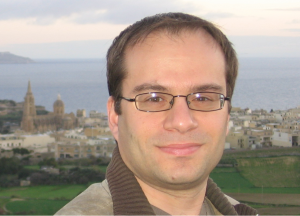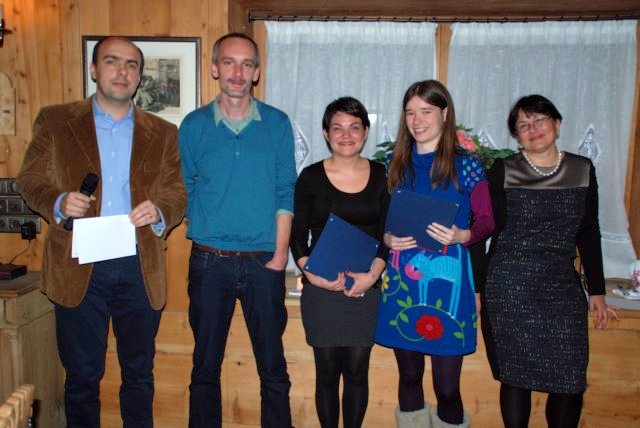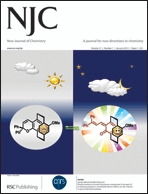
Prof. George Gokel
Our first author is George Gokel, a former NJC Associate Editor, who is Distinguished Professor of Science and Director of the Center for Nanoscience at the University of Missouri-St. Louis. George’s research is in the field of supramolecular and biological chemistry of membrane active and channel-forming compounds.
The article by George and his co-authors looks into the little-studied branched-chain chemistry of pyrogallolarenes. These compounds have led to at least one remarkable nanotube structure. The group’s NJC paper addresses the membrane behavior of resorcinarenes that have hard-to-obtain, very long chains that are aligned (rccc). The typical synthesis of pyrogallols depends on crystallization of a single product from a complex mixture. Long-chain pyrogallols or resorcinarenes crystallize poorly owing to their extended hydrocarbon chains. Jochen Mattay had previously prepared and characterized very long chain compounds containing varied headgroups. The collaboration with the group of Gokel probed the monolayer behavior (Langmuir trough) and membrane activity (bilayer clamp) to obtain new information about the amphiphilic behavior of these difficult-to-obtain derivatives.
One of George’s favorite films is KPAX. In this film, Kevin Spacey claims to be a tourist from the planet KPAX. Jeff Bridges plays the psychiatrist who seeks conventional explanations for a range of phenomena that point to Spacey’s alien origins. George applies the moral of this film to science: “It humbles one to think that we often try to make our data fit our preconceived notions rather than applying Sherlock Holmes’ advice in the Sign of the Four that ‘when you have eliminated the impossible, whatever remains, however improbable, must be the truth.'”
Properties of long alkyl-chained resorcin[4]arenes in bilayers and on the Langmuir trough by Priyanka Ogirala, Saeedeh Negin, Ceno Agena, Christian Schäfer, Thomas Geisler, Jochen Mattay and George W. Gokel, New J. Chem., 2013, 37, 105–111. DOI: 10.1039/C2NJ40337D

Luca (on the right) indulging in one of his passions with two friends.
The second NJC board member is Luca Prodi, who is a Full Professor in the Chemistry Department “G. Ciamician” of the University of Bologna.
Luca explains how his research interests have expanded over the years, while remaining centered on light: “I have been always fascinated by luminescence-related processes. Because of this curiosity, I directed my interest to the design of luminescent chemosensors and labels, especially for biological applications. The advent of nanotachnology has allowed the design of brighter systems, and for this reason I have recently started the study of nanoparticles, in particular those possessing a silica core. The possibility to design multicomponent systems opens up a huge number of strategies to improve the analytical signal. It is not possible to get bored studying these materials!”
All of these topics come together in the Focus review contributed by the Prodi group. “The design of chemosensors able to give information about the concentration of a given analyte can have a tremendous impact on many disciplines, such as medical diagnosis, molecular biology, and environmental monitoring, to cite only a few. Since the use of chemosensors based on silica nanoparticles is, to our opinion, very promising for obtaining systems featuring better performances, we have reviewed some interesting examples of what is reported in the literature indicating also some perspectives in the field.”
Reading is one of Luca’s favourite activities besides chemistry (and cycling—see the photo!). He notes that he is a “curiosity-driven reader” so his interests span many areas but in particular he likes detective stories by northern Europe writers, while one of his favourite Italian authors is Andrea Camilleri; Luca particularly enjoyed reading the first novel by this author, introducing Inspector Montalbano in La Forma dell’Acqua (The Shape of Water—sounds quite fitting for a chemist!).
Luminescent chemosensors based on silica nanoparticles for the detection of ionic species by Marco Montalti, Enrico Rampazzo, Nelsi Zaccheroni and Luca Prodi, New J. Chem., 2013, 37, 28–34. DOI: 10.1039/C2NJ40673J

David visiting Mgarr in Malta, with a view of the harbor and church.
Lastly let us meet David C. Magri, a recently appointed Senior Lecturer in the Department of Chemistry, University of Malta (Malta is a small archipelago in the Mediterranean Sea, with a long and fascinating history, having been ruled by a succession of powers going from the Phoenicians to the British crown). Getting back to David, his research is in the area of luminescent sensors and molecular logic gates.
In their NJC paper, David with student Thomas report the first examples of molecular AND logic gates that can simultaneously measure the pH and the pE (redox ability of a solution). In honour of Marcel Pourbaix, a formerly renowned electrochemist, they have named them Pourbaix sensors. Such probes could be useful in environmental monitoring, and also in cell biology and medicine, for example, as high concentrations of protons and redox active metal ions, such as iron, have been linked to certain types of cancer.
With a background in both photochemistry and electrochemistry David often contemplated how to intertwine elements from both to the field of molecular information processing. Fluorescent logic gates for pH and pE was the result.
A book that has left its mark on David from his graduate training is The Structure of Scientific Revolutions by Thomas S. Kuhn (published in 1962 by the University of Chicago Press). David explains: “The book explores the psychology of science dealing with the acceptance of new paradigms. I would recommend all researchers give it a read.”
‘Pourbaix sensors’: a new class of fluorescent pE–pH molecular AND logic gates based on photoinduced electron transfer by Thomas J. Farrugia and David C. Magri, New J. Chem., 2013, 37, 148–151. DOI: 10.1039/C2NJ40732A
We hope you enjoyed meeting some of your fellow chemists. Check back next month on the NJC blog to see who we’ll interview next!
Comments Off on Meet Our Authors from the January 2013 Issue of NJC


























